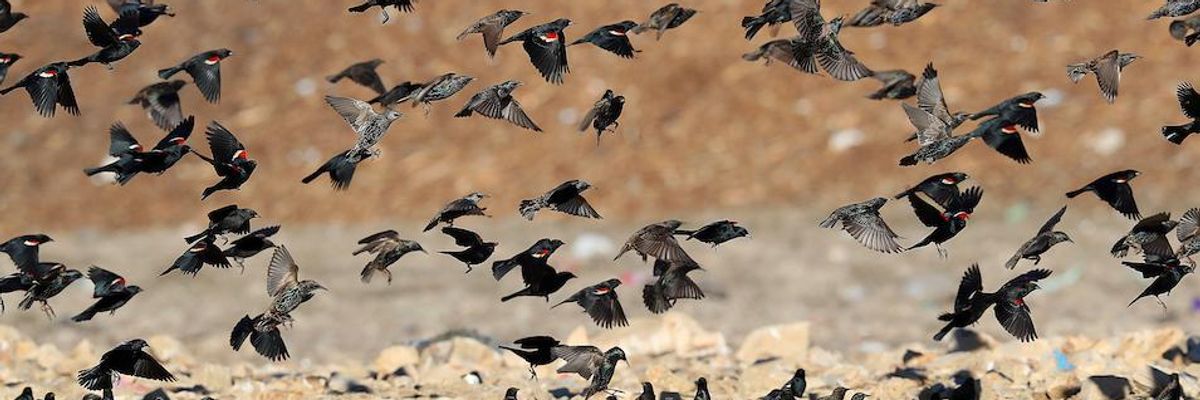
A group including tricolored blackbirds, red-winged blackbirds, and starlings take flight at the City of Santa Cruz Resource Recovery Facility on Thursday, Dec. 13, 2018 in Santa Cruz, Calif. (Photo:Aric Crabb/Digital First Media/Bay Area NewsGetty Images)
'Bird Emergency' as Study Shows North American Bird Population Has Fallen by Nearly One-Third in Less Than 50 Years
"We have to act now to protect the places we know birds rely on."
North America lost 29 percent of its bird populaiton--around three billion birds--over the last 49 years, according to a new report.
"Decline of the North American avifauna," a study released on Thursday in the journal Science, found that the continent has seen a net loss of 2.9 billion birds since 1970.
"The birds are the canary in the coal mine," The Bird Conservancy of the Rockies' Arvind Panjabi, a study author, told Gizmodo. "When the birds are dying, it surely can't be good for us either."
Researchers found that "90% of the loss can be attributed to just a dozen bird families, including sparrows, warblers, blackbirds, and finches," according to NPR.
Common birds with decreasing populations include meadowlarks, dark-eyed juncos, horned larks and red-winged blackbirds, says Rosenberg. Grassland birds have suffered a 53% decrease in their numbers, and more than a third of the shorebird population has been lost.
The report is a dire warning, said Cornell University's Kenneth V. Rosenberg, the study's lead author.
"We were stunned by the result," Rosenberg told The New York Times. "It's just staggering."
In a statement, National Audobon Society president David Yarnold declared the findings indicative of "a full-blown crisis that requires political leadership as well as mass individual action."
"This is a bird emergency with a clear message: the natural world humans depend on is being paved, logged, eroded, and polluted," Yarnold said.
Protecting the natural world is essential to saving birds and humans alike, said Yarnold.
"We have to act now to protect the places we know birds rely on," Yarnold said. "Places like the Arctic Refuge, Great Lakes, Everglades, and Colorado River must be a priority."
T. Scott Sillett, the head of the Smithsonian Migratory Bird Center, told Scientific American that the study--which he did research for--shows that the climate crisis is approaching critical levels and that immediate steps must be taken to repair the environmental damage that has depleted the continent's bird population.
"A lot of migratory habitat for shorebirds and wintering habitat has been lost," said Sillett. "This study points out that we have a lot more work to do in terms of habitat protection."
An Urgent Message From Our Co-Founder
Dear Common Dreams reader, The U.S. is on a fast track to authoritarianism like nothing I've ever seen. Meanwhile, corporate news outlets are utterly capitulating to Trump, twisting their coverage to avoid drawing his ire while lining up to stuff cash in his pockets. That's why I believe that Common Dreams is doing the best and most consequential reporting that we've ever done. Our small but mighty team is a progressive reporting powerhouse, covering the news every day that the corporate media never will. Our mission has always been simple: To inform. To inspire. And to ignite change for the common good. Now here's the key piece that I want all our readers to understand: None of this would be possible without your financial support. That's not just some fundraising cliche. It's the absolute and literal truth. We don't accept corporate advertising and never will. We don't have a paywall because we don't think people should be blocked from critical news based on their ability to pay. Everything we do is funded by the donations of readers like you. Will you donate now to help power the nonprofit, independent reporting of Common Dreams? Thank you for being a vital member of our community. Together, we can keep independent journalism alive when it’s needed most. - Craig Brown, Co-founder |
North America lost 29 percent of its bird populaiton--around three billion birds--over the last 49 years, according to a new report.
"Decline of the North American avifauna," a study released on Thursday in the journal Science, found that the continent has seen a net loss of 2.9 billion birds since 1970.
"The birds are the canary in the coal mine," The Bird Conservancy of the Rockies' Arvind Panjabi, a study author, told Gizmodo. "When the birds are dying, it surely can't be good for us either."
Researchers found that "90% of the loss can be attributed to just a dozen bird families, including sparrows, warblers, blackbirds, and finches," according to NPR.
Common birds with decreasing populations include meadowlarks, dark-eyed juncos, horned larks and red-winged blackbirds, says Rosenberg. Grassland birds have suffered a 53% decrease in their numbers, and more than a third of the shorebird population has been lost.
The report is a dire warning, said Cornell University's Kenneth V. Rosenberg, the study's lead author.
"We were stunned by the result," Rosenberg told The New York Times. "It's just staggering."
In a statement, National Audobon Society president David Yarnold declared the findings indicative of "a full-blown crisis that requires political leadership as well as mass individual action."
"This is a bird emergency with a clear message: the natural world humans depend on is being paved, logged, eroded, and polluted," Yarnold said.
Protecting the natural world is essential to saving birds and humans alike, said Yarnold.
"We have to act now to protect the places we know birds rely on," Yarnold said. "Places like the Arctic Refuge, Great Lakes, Everglades, and Colorado River must be a priority."
T. Scott Sillett, the head of the Smithsonian Migratory Bird Center, told Scientific American that the study--which he did research for--shows that the climate crisis is approaching critical levels and that immediate steps must be taken to repair the environmental damage that has depleted the continent's bird population.
"A lot of migratory habitat for shorebirds and wintering habitat has been lost," said Sillett. "This study points out that we have a lot more work to do in terms of habitat protection."
North America lost 29 percent of its bird populaiton--around three billion birds--over the last 49 years, according to a new report.
"Decline of the North American avifauna," a study released on Thursday in the journal Science, found that the continent has seen a net loss of 2.9 billion birds since 1970.
"The birds are the canary in the coal mine," The Bird Conservancy of the Rockies' Arvind Panjabi, a study author, told Gizmodo. "When the birds are dying, it surely can't be good for us either."
Researchers found that "90% of the loss can be attributed to just a dozen bird families, including sparrows, warblers, blackbirds, and finches," according to NPR.
Common birds with decreasing populations include meadowlarks, dark-eyed juncos, horned larks and red-winged blackbirds, says Rosenberg. Grassland birds have suffered a 53% decrease in their numbers, and more than a third of the shorebird population has been lost.
The report is a dire warning, said Cornell University's Kenneth V. Rosenberg, the study's lead author.
"We were stunned by the result," Rosenberg told The New York Times. "It's just staggering."
In a statement, National Audobon Society president David Yarnold declared the findings indicative of "a full-blown crisis that requires political leadership as well as mass individual action."
"This is a bird emergency with a clear message: the natural world humans depend on is being paved, logged, eroded, and polluted," Yarnold said.
Protecting the natural world is essential to saving birds and humans alike, said Yarnold.
"We have to act now to protect the places we know birds rely on," Yarnold said. "Places like the Arctic Refuge, Great Lakes, Everglades, and Colorado River must be a priority."
T. Scott Sillett, the head of the Smithsonian Migratory Bird Center, told Scientific American that the study--which he did research for--shows that the climate crisis is approaching critical levels and that immediate steps must be taken to repair the environmental damage that has depleted the continent's bird population.
"A lot of migratory habitat for shorebirds and wintering habitat has been lost," said Sillett. "This study points out that we have a lot more work to do in terms of habitat protection."

